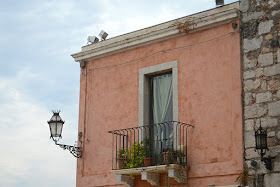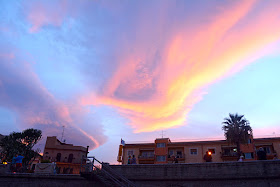First things first: because we
are inept travelers who love their pint or three of something, we generally
skip the hire a car part, which, as you shall see, is particularly irksome in
Sicily. This also implies that our mobility is somewhat limited by the quirks
and whims of local transportation companies, and we therefore cover less of
everything- I would love to say that we do it more thoroughly in exchange, but
this statement might not be that valid either. So the scientific review below
will thus concentrate on the Ionian coast of Sicily, as it extends from Messina
(where we haven’t been) to Syracuse (where we have).
How to get there. Flying is probably the best option
irrespective of whether you are already in Italy or abroad, as a quick perusal
of the Trenitalia connections to Rome and Milan uncovers a world of meandering
rails, uncertain timetables and most probably massive discomfort. Our experience with buses wasn’t all that
inspiring either, so the top tip is to avoid them as long as you can. The main airport in the area is Catania Fontanarossa, also poetically named Vincenzo Bellini. Italians love an artsy
touch, don’t they, not that many others would know that, for example, Roma
Fiumicino is also called Leonardo Da Vinci, nor does the state of the
contraption live up to the might of its namesake.
Catania Fontanarossa is however a
not overly grand, but pretty clean and functional terminal, and it has flights
connecting it to most of the major European destinations- Wizzair has services
from Budapest, Bucharest and both Warsaw and Katowice in Poland, while
Alitalia, should you trust them with your luggage, offers several transfer
options through Rome and Milan. Those of incredibly adventurous disposition can
also travel by car and catch a ferry to Messina from Reggio Calabria on the
continent- several Italian governments have harboured pipe dreams of building a
majestic bridge over the straits, but every now and then a desperate Italian
scientist will bludgeon some sense into them referring to delicate details
about how the area is infested with active volcanoes and pretty earthquake
prone. Or, more realistically, they simply realize they can’t embezzle enough
money and leave it at that.
How to get around. The
answer is simple: by car. It seems everyone of driving age has one, usually
some slightly battered Fiat model, with a few of them looking like they served
well their first owner, a Roman centurion who catered for them alongside a
horse and a donkey. Trips to the greengrocer’s, butcher’s or the children’s
kindergarden located on an adjacent street will all be done aboard a vehicle,
more often than not with a gesticulating arm flailing through the open window. Should
you ask directions and confess that you wish to make the dangerous five minute journey on
foot, much referencing of Jesus and the Madonna will ensue and your counterpart
will then admit with a sigh that the thought never crossed their mind,
therefore they can be of no help whatsoever. Scenes of absolute despair unfold
in front of ubiquitous mechanic’s shops, where harassed gentlemen run around
informing devastated owners that the car might just be ready by tomorrow’s mass
or outing to the cemetery. Might, but not for sure. In Sicily, nothing is
really quite sure. Car rental offices are therefore plentiful, both around the
airport and in all major resorts, and prices are generally fair- it’s best however
to ask a local beforehand and most hotels will have a list of recommended
places.
Should you, for no good reason really,
opt for a car-less holiday, like we did, you will have to rely on buses and
trains. Transport in Sicily has a generally fragmented nature- two major cities
relatively close to each other will be connected directly, but in case you want
to embark on a more complicated undertaking, you will most probably have to
switch rides at some point. Sticking to the Ionian coast you will however be
pretty well catered for by the Interbus network- it even runs almost on time,
with the occasional quarter of an hour delay on longer connections. In such
situations the most important thing is not to panic or wish for clarity- nobody
knows why the bus is late, nobody knows when it will arrive, but it will be
soon (the local definition of which might be slightly different to yours) and you should just calmly accept your fate. Tickets are available for
purchase from the drivers, but it’s advisable to buy them in advance and you
should also be prepared for popular connections to be completely full when they
arrive at smaller stops. A good option for the Taormina-Giardini Naxos area is
the daily 10 euro ticket, which allows you to travel between several beach
areas and all the way to the gorges of the Alcantara river.
Certain longer connections, for
example the Messina-Syracuse one are, ideally, better by train. Fragmentation
is a major factor here as well and due to the rail network being focused mostly
around the coast, some trips will take you on detours along less modern lines. Regional
fast trains (RV- Regionale Veloce on Trenitalia boards) are pretty comfortable
and affordable but could, might, and will be late. In smaller stations the
ticket counter will often be closed according to whimsical schedules, but you
can nevertheless buy tickets from the self-service counters and, naturally, the
café-bar. Tickets must always be validated prior to travel at the designated machines:
should you board the train with an untouched ticket you will most likely be
fined- a recent campaign aimed at cutting down on people re-using tickets has
made controls stricter and train conductors are reluctant to be lenient even
when one claims touristy folly.
Although they are rather handsome
devices, RVs will however malfunction every now and then, generally when you’d
most need them not to. And thus it happened that, already a bit prickly about an
hour long delay on a two hour connection (reasons, evidently, unknown), we were
unable to leave the train at Taormina station due to the door not working. The allotted
time of maneuvering in and out of the carriage at that particular stop is of 30
seconds, and I really wish to offend no one, but I find it hard to believe that
the Swiss or the Germans would be able to complete this operation successfully,
so Italians stand really no chance at all. But, due to some wishful thinking
from Trenitalia, 30 seconds it was, and by the time we made it to another, possibly
functional door, we were already hurtling through the scenic coastal region
towards Messina. Led by a boundlessly revolted Northerner we located the
capotreno who, with a Cheshire cat grin, informed us that we are essentially morons
who can’t operate primitive systems such as doors and that we shall therefore
be unceremoniously disembarked at Letojanni, from where we should find our
stupid way back home.
Thus we learned from a completely
bewildered local that taxis are unheard of in Letojanni- naturally, since
everyone is aboard their own private minute Fiat, and we should just pray to
the Madonna that late buses are still running as during high season. They were-
or weren’t, since the bus driver, equally bewildered by our presence gave us a
ticket which had ‘Bus 99-Infinite’ written on it and hoisted us up to Taormina,
from where we could take the normal connection back to Giardini Naxos.
This long odyssey of mysterious
names might require some explanation: the jewel of the Ionian coast, Taormina,
to the further bewilderment of tourists, Italian and foreign alike, is actually
not by the sea, but perched on the rocks above the shore. It therefore has no
beaches itself- this role is fulfilled by the beaches of Letojanni,
approachable by bus, and Mazzaró, which is connected to Taormina by cable car-
the trip lasts a five minute maximum. These beaches are however pretty
expensive, so a safe bet is to choose the homelier sister village of Giardini
Naxos instead- accommodation and food are both cheaper here, and there is a
long stretch of enjoyable sandy beaches as well. Even higher up the rocks you can find
Castelmola, the sole real purpose of which is to provide great views of
Taormina and Etna on the horizon.
Where to Stay. There are plenty of options for accommodation and
the mid-range ones are particularly good when it comes to value for price.
Generally speaking, Sicilian prices are affordable- scared by the decrease in
tourists during the crisis, locals opted to keep them down in the hope of
attracting more people, which seems to have worked out quite well for both
sides. Most international booking sites will have a handsome list of small
hotels, many of them family run (‘bed and breakfasts’ typically have a maximum
of four rooms, while a ‘pensione’ is somewhat larger, but still not a full
blown hotel).
Taormina is of course the priciest, the affordable options being usually hidden away in small alleyways without the best of views- for that, one might opt for Castelmola instead, whereas Giardini Naxos provides views of the Etna and the closeness to some fine beaches. You could probably choose to stay in Messina or Catania as well, but why would you really- they are both worth a one day visit in case you have plenty of time on your hands but for a one week stay they are cities you can skip without deep regrets.
Taormina is of course the priciest, the affordable options being usually hidden away in small alleyways without the best of views- for that, one might opt for Castelmola instead, whereas Giardini Naxos provides views of the Etna and the closeness to some fine beaches. You could probably choose to stay in Messina or Catania as well, but why would you really- they are both worth a one day visit in case you have plenty of time on your hands but for a one week stay they are cities you can skip without deep regrets.
















































No comments:
Post a Comment